GANGA SAGAR MELA
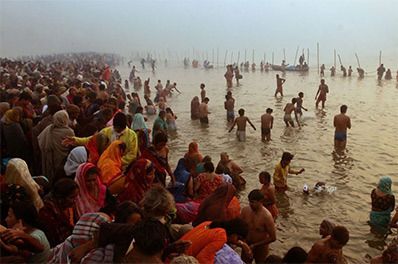
Another festival celebrating the holy Ganges, Ganga Sagar Mela is the second-largest religious congregation held in the country after Kumbh Mela. As festival dates depend upon the positioning of the Zodiac signs and stars, the date for this festival is also decided based on Sun entering a particular position, which usually takes place in the month of January every year. And taking bath in the holy river Ganges during this moment of time is considered auspicious. The time is also celebrated as another important festival called Makar Sakranti in many parts of India. Approx. 100 kms from Kolkata, Ganga Sagar Mela is held at the confluence of Ganges and Bay of Bengal, and thousands of people visit here to take a holy dip followed by a visit to the Kapil Muni temple nearby.
We already shared with you the story about King Bhagiratha earlier (under Ganga Dussehra), Kapil Muni was the sage who cursed King Sagar's 60000 sons to turn into ashes, and Bhagiratha prayed to Ganges to come down to earth to enable him to immerse their ashes.
Importance of Rivers in other religious festivals of India
Chhath Puja: Dedicated to Sun God, in this annual four-day-long festival, devotees worship the first ray of the Sun in the morning and the last ray in the evening. One of the rituals, among many, is taking a bath in the Holy River.

During Chhath Puja, thousands of devotees take a dip in Ganges, Yamuna and in other holy rivers in India. The festival is celebrated six days after Diwali or on the sixth day of the Kartik month in the Hindu calendar that usually falls in the month of November every year.
The festival is unique to the states of Bihar and Uttar Pradesh which are also famous for numerous Buddhist and historical sites.
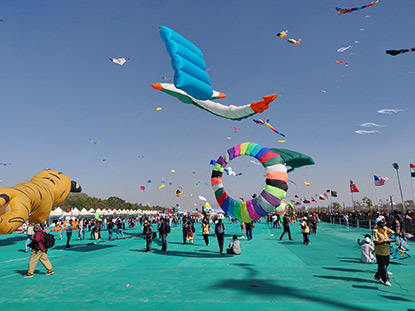 Makar Sakranti:
Makar Sakranti: Another festival dedicated to Sun God, which marks the end of the month with the winter solstice and the start of longer days. The worshipping or the celebrations start with a bath in the Holy River. The festival is celebrated with different names in different parts of the country in the month of January. In many parts of the country, people also fly kites on this day. For the overseas visitors an International Kite Festival is celebrated in Gujarat and various other states of India.
It has become synonymous with Makar Sakranti. Of late, this festival in Gujarat attracted visitors from several countries like Japan, Italy, USA, Malaysia, Singapore, France, UK, Canada, Australia, Brazil, China and Indonesia who take part in the kite flying competitions.
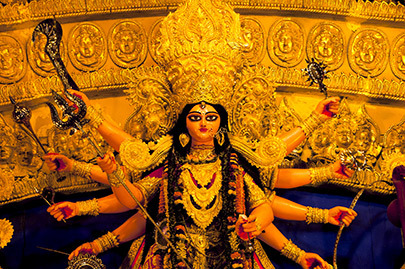 Durga Puja:
Durga Puja: Dedicated to Goddess Durga, this ten-day festival concludes with the immersion of the idol of Goddess in a river following religious rituals. The festival coincides with other festivals of Navratra and Dussehra celebrations.
Usually, this festival is celebrated either in the month of October or November and Kolkata is the best place to witness this vibrant festival.
Watch how Durga Puja is celebrated in West Bengal in this beautiful video.
Aadi Perukku: The festival is celebrated to honour water bodies for their significant role in sustaining life in Tamil Nadu. The festival date falls in mid-July when the monsoon sets in Tamil Nadu, and when farmers get ready for sowing the crop. So, they pray and thank all the water bodies for sufficient water they need in their day-to-day life.
Apart from religious celebrations, river banks also host some of the famous art and culture festivals. Such cultural festivals, also promoted as river festivals are organized to emphasize the importance of rivers in our lives and strengthening of the public-river connect. Some of these festivals are:
 Ganga Mahotsav, Ganges:
Ganga Mahotsav, Ganges: This five-day annual festival celebrated every year after Diwali is organized along the ghats of the River Ganges in Varanasi. It showcases the city's rich culture and traditions and strengthening of the public-river connect. The celebrations includes crafts fair, stage performances, traditional Indian sports like country boat-race, Indian style wrestling competitions etc.
The last day of the festival coincides with Dev Deepawali, the grand and most sought after festival of Varanasi, when Gods are believed to descend to earth to bathe in the river Ganges.
Sacred River Festival, Narmada: The festival is organized and celebrated every year in the third week of February for 03 days in Maheshwar, Madhya Pradesh. Cultural performances, including dance and music on the banks of river Narmada, are the highlight during this festival. The majestic Ahilya fort on the river bank, which is beautifully decorated and lit up, is the best place to stay during festival times.
Watch a glimpse of this festival.
Malabar River Festival: The festival hosts a white water kayaking championship every year in July. The championship is held in Kozhikode (Kerala) in Chaliyar, Iruvanjippuzha, and Chalippuzha rivers. Kayakers from different countries participate in this competition.
Siang River Festival: Also known as the Yomgo river festival, this annual festival is celebrated in January in Arunachal Pradesh. While promoting ecotourism, the festival hosts a variety of cultural, traditional, and adventure activities.
 Sindhu Darshan festival:
Sindhu Darshan festival: Held every year in June on the banks of river Indus (also known as river Sindhu), in Ladakh, this three-day festival draws focus to the Sindhu river as a symbol of the India’s National Integration and unity among diversity. The festival is also known as Singhe Kabaab Festival and features cultural events such as musical shows, art exhibitions and dance performances, organised by artistes belonging to different parts of India.
In India, rivers have been given a special significance and remained an object of worship, since time immemorial. Apart from their life-sustaining properties, rivers also play a vital role in many religious ceremonies and rites. Come and explore the rivers of India with us, either by witnessing a mesmerising river-bank festival or simply by indulging in river cruising. With us, the itinerary is not just a travel route or a trip. We design, conceptualize and handcraft every journey for you. Our bespoke itineraries and curated experiences in different destinations are what make for those memorable travel moments.

 Recognized with the “Safe Travel Stamp”, from WTTC (World Travel and Tourism Council), Indo Asia Tours is aligned with the ‘Safe Travel protocols’, adhering to our responsibilities as a responsible tour operator and have adopted health and hygiene global standardized protocols.
Recognized with the “Safe Travel Stamp”, from WTTC (World Travel and Tourism Council), Indo Asia Tours is aligned with the ‘Safe Travel protocols’, adhering to our responsibilities as a responsible tour operator and have adopted health and hygiene global standardized protocols.
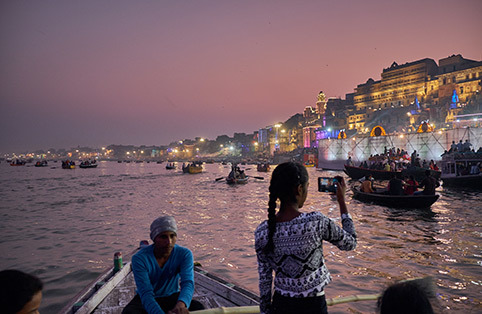 Ganga Dussehra, which marks the day when Ganges descended on earth, makes the rituals more auspicious and important. So, a large number of people gather on the Ghats of the Ganges to take a holy dip, do charities, and seek blessings of this pious river to wash off the sins, committed knowingly or unknowingly. The religious flavour that can be felt throughout the day is glorified in the evening by the beauty of the floating earthen lamps on the river and lively surroundings during the aarti ceremony, which is a grand sight than other normal days.
Ganga Dussehra, which marks the day when Ganges descended on earth, makes the rituals more auspicious and important. So, a large number of people gather on the Ghats of the Ganges to take a holy dip, do charities, and seek blessings of this pious river to wash off the sins, committed knowingly or unknowingly. The religious flavour that can be felt throughout the day is glorified in the evening by the beauty of the floating earthen lamps on the river and lively surroundings during the aarti ceremony, which is a grand sight than other normal days.
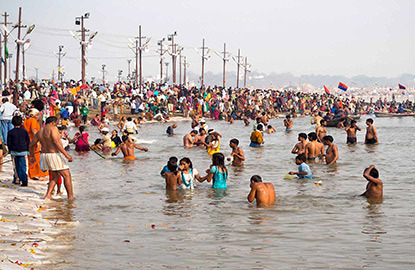 Kumbh literally means an earthen pot, but it actually is the confluence of all our cultures. A major pilgrimage of Hindus, the festival is celebrated every third year, switching among the 04 river-bank religious sites, namely Haridwar (Uttarakhand), Prayagraj (Uttar Pradesh), Ujjain (Madhya Pradesh), and Nasik (Maharashtra), in a cycle of 12 years. While it returns to each site only after 12 years as PURAN (full) KUMBH, the chronology is such that ARDH (half or six yearly) KUMBH falls either in Haridwar or in Prayagraj only.
Kumbh literally means an earthen pot, but it actually is the confluence of all our cultures. A major pilgrimage of Hindus, the festival is celebrated every third year, switching among the 04 river-bank religious sites, namely Haridwar (Uttarakhand), Prayagraj (Uttar Pradesh), Ujjain (Madhya Pradesh), and Nasik (Maharashtra), in a cycle of 12 years. While it returns to each site only after 12 years as PURAN (full) KUMBH, the chronology is such that ARDH (half or six yearly) KUMBH falls either in Haridwar or in Prayagraj only. 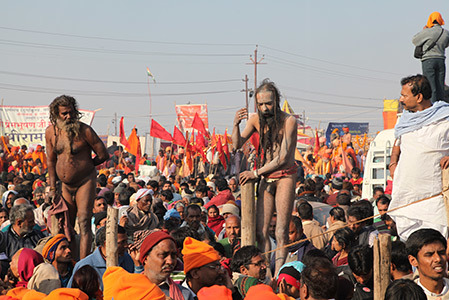 Apart from the bathing rituals in the holy river and other religious ceremonies, one can also see several holy men like Naga sadhus (Priests who do not wear clothes), Kalpawasis (people who take bath three times a day), and Urdhawavahurs (these follow the practice of putting severe austerities to body).
Apart from the bathing rituals in the holy river and other religious ceremonies, one can also see several holy men like Naga sadhus (Priests who do not wear clothes), Kalpawasis (people who take bath three times a day), and Urdhawavahurs (these follow the practice of putting severe austerities to body).
 Another festival celebrating the holy Ganges, Ganga Sagar Mela is the second-largest religious congregation held in the country after Kumbh Mela. As festival dates depend upon the positioning of the Zodiac signs and stars, the date for this festival is also decided based on Sun entering a particular position, which usually takes place in the month of January every year. And taking bath in the holy river Ganges during this moment of time is considered auspicious. The time is also celebrated as another important festival called Makar Sakranti in many parts of India. Approx. 100 kms from Kolkata, Ganga Sagar Mela is held at the confluence of Ganges and Bay of Bengal, and thousands of people visit here to take a holy dip followed by a visit to the Kapil Muni temple nearby.
Another festival celebrating the holy Ganges, Ganga Sagar Mela is the second-largest religious congregation held in the country after Kumbh Mela. As festival dates depend upon the positioning of the Zodiac signs and stars, the date for this festival is also decided based on Sun entering a particular position, which usually takes place in the month of January every year. And taking bath in the holy river Ganges during this moment of time is considered auspicious. The time is also celebrated as another important festival called Makar Sakranti in many parts of India. Approx. 100 kms from Kolkata, Ganga Sagar Mela is held at the confluence of Ganges and Bay of Bengal, and thousands of people visit here to take a holy dip followed by a visit to the Kapil Muni temple nearby.
 During Chhath Puja, thousands of devotees take a dip in Ganges, Yamuna and in other holy rivers in India. The festival is celebrated six days after Diwali or on the sixth day of the Kartik month in the Hindu calendar that usually falls in the month of November every year.
During Chhath Puja, thousands of devotees take a dip in Ganges, Yamuna and in other holy rivers in India. The festival is celebrated six days after Diwali or on the sixth day of the Kartik month in the Hindu calendar that usually falls in the month of November every year. Makar Sakranti: Another festival dedicated to Sun God, which marks the end of the month with the winter solstice and the start of longer days. The worshipping or the celebrations start with a bath in the Holy River. The festival is celebrated with different names in different parts of the country in the month of January. In many parts of the country, people also fly kites on this day. For the overseas visitors an International Kite Festival is celebrated in Gujarat and various other states of India.
Makar Sakranti: Another festival dedicated to Sun God, which marks the end of the month with the winter solstice and the start of longer days. The worshipping or the celebrations start with a bath in the Holy River. The festival is celebrated with different names in different parts of the country in the month of January. In many parts of the country, people also fly kites on this day. For the overseas visitors an International Kite Festival is celebrated in Gujarat and various other states of India.
 Durga Puja: Dedicated to Goddess Durga, this ten-day festival concludes with the immersion of the idol of Goddess in a river following religious rituals. The festival coincides with other festivals of Navratra and Dussehra celebrations.
Durga Puja: Dedicated to Goddess Durga, this ten-day festival concludes with the immersion of the idol of Goddess in a river following religious rituals. The festival coincides with other festivals of Navratra and Dussehra celebrations.
 Ganga Mahotsav, Ganges: This five-day annual festival celebrated every year after Diwali is organized along the ghats of the River Ganges in Varanasi. It showcases the city's rich culture and traditions and strengthening of the public-river connect. The celebrations includes crafts fair, stage performances, traditional Indian sports like country boat-race, Indian style wrestling competitions etc.
Ganga Mahotsav, Ganges: This five-day annual festival celebrated every year after Diwali is organized along the ghats of the River Ganges in Varanasi. It showcases the city's rich culture and traditions and strengthening of the public-river connect. The celebrations includes crafts fair, stage performances, traditional Indian sports like country boat-race, Indian style wrestling competitions etc.
 Sindhu Darshan festival: Held every year in June on the banks of river Indus (also known as river Sindhu), in Ladakh, this three-day festival draws focus to the Sindhu river as a symbol of the India’s National Integration and unity among diversity. The festival is also known as Singhe Kabaab Festival and features cultural events such as musical shows, art exhibitions and dance performances, organised by artistes belonging to different parts of India.
Sindhu Darshan festival: Held every year in June on the banks of river Indus (also known as river Sindhu), in Ladakh, this three-day festival draws focus to the Sindhu river as a symbol of the India’s National Integration and unity among diversity. The festival is also known as Singhe Kabaab Festival and features cultural events such as musical shows, art exhibitions and dance performances, organised by artistes belonging to different parts of India.
 Thank you, patrons, for reposing faith in our destinations and enquiring for customised virtual destination awareness training programs. We are proud to conduct them successfully so far and are looking forward to hold similar virtual destination awareness training programs for your team or yourself or a virtual tour for your clients. Let us know the destination of your interest along with your convenient date / time and we will be happy to set up a program for you.
Thank you, patrons, for reposing faith in our destinations and enquiring for customised virtual destination awareness training programs. We are proud to conduct them successfully so far and are looking forward to hold similar virtual destination awareness training programs for your team or yourself or a virtual tour for your clients. Let us know the destination of your interest along with your convenient date / time and we will be happy to set up a program for you.



